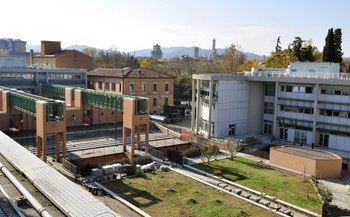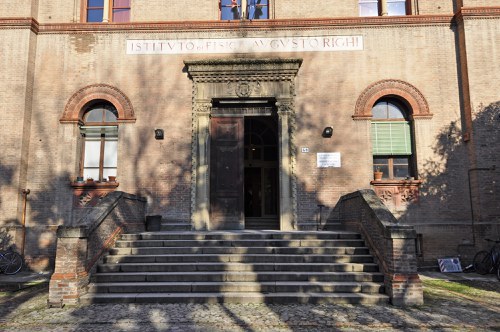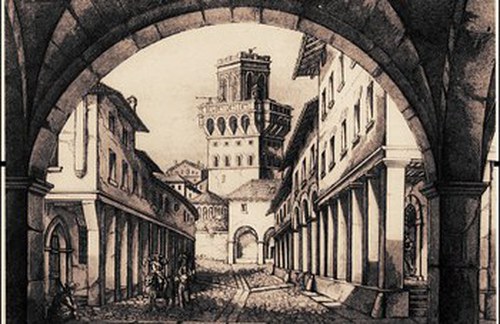The Origins of DIFA
The Merger of the Departments of Physics and Astronomy

The Department of Physics and Astronomy (DIFA) – named in memory of Augusto Righi during the Righi100 Celebrations held in 2020 – was established in 2012 following the merger of the Departments of Physics and Astronomy at the University of Bologna.
To the historic locations of Via Irnerio 46 (Physics Department) and the Torre della Specola (Astronomy Department), were added the large site on Viale Berti Pichat (numbers 6/2 and 8), which hosts numerous laboratories as well as the administrative offices and management, and the new Navile site, which houses the astrophysics sector.

History of the Physics Department
Physics in Bologna has deep roots, intertwined with the study and research activities of various public and private institutions and the ancient Studium of Bologna.
In the second half of the 17th century, during the flourishing of early studies on light by Isaac Newton and Christian Huygens, Jesuit Francesco Maria Grimaldi of the Collegio di S. Lucia conducted the first quantitative study on “diffraction,” a term he coined to describe a new property of light distinct from reflection, refraction, and rectilinear propagation. His fruitful collaboration with astronomer Giovanni Battista Riccioli opened Bologna’s physics to another central theme of the time: the study of mechanical phenomena, confirmed by the verification of Galileo’s law of falling bodies from the Torre degli Asinelli.
The extraordinary figure of nobleman, soldier, and scientist Luigi Ferdinando Marsili, supported by the Senate with the acquisition of Palazzo Poggi, led to the founding of the Institute of Sciences in 1711. This autonomous institute, complementary to the Studium and inspired by Newton’s theories, greatly advanced scientific disciplines. It was within this Institute that the city’s first physics chair was created for physicist and chemist Jacopo Bartolomeo Beccari, known for discovering gluten.
In 1728, Francesco Maria Zanotti and student Francesco Algarotti replicated Newton’s light experiments from Opticks for the first time in Italy. In 1791, Luigi Galvani developed the revolutionary concept of “animal electricity.” Also in the 18th century, Laura Bassi became the first woman to hold a university chair in philosophy and physics, gaining international fame for her experimental physics lectures.
In the early 19th century, Napoleonic reforms moved the Studium from the Archiginnasio to Palazzo Poggi, giving rise to the modern University of Bologna. The new Physics Cabinet focused on electrical and magnetic phenomena, with major contributions from Giovanni Aldini, who defended Galvani’s theories against Alessandro Volta. The century closed with Augusto Righi, whose work laid the experimental foundations of Maxwell’s electromagnetic theory and the basis for wireless telegraphy, paving the way for Guglielmo Marconi’s discoveries.
After the founding of the University’s Institute of Physics in 1907, Righi steered Bologna’s physics toward the study of matter’s structure, shaping 20th-century research. Quirino Majorana continued applied research, founding a two-year advanced school in radio and telecommunications in 1931 and playing a key role in launching engineering programs in electrical, electronic, and telecommunications fields.
After WWII, Giampietro Puppi, known internationally for his work on weak interactions, initiated new research in nuclear and particle physics, including collaborations with major international facilities like CERN. His efforts in theoretical physics, matter structure, and applied physics, along with the creation of Bologna’s geophysics sector, led the Institute toward becoming a modern department.

History of the Astronomy Department
Astronomy in Bologna dates back to the early days of the university Studium. The first documented astronomy teaching dates to 1297, in a manuscript by Bartolomeo da Parma.
Many renowned astronomers taught at the university, including Girolamo Manfredi, Domenico Maria da Novara, Giacomo Pietramellara (15th century), Egnazio Danti, Giovanni Magini (16th century), Bonaventura Cavalieri, Gian Domenico Cassini, Geminiano Montanari (17th century), Eustachio Manfredi, Eustachio Zanotti (18th century), Lorenzo Respighi (19th century), and Guido Horn d’Arturo in the 20th century.
Equally notable were the students, including Dante Alighieri, Nicolaus Copernicus, and Bruno Rossi.
Modern astronomy flourished in the mid-20th century thanks to Horn d’Arturo’s school, which in 1936 established the Loiano Astronomical Station with a 60 cm Zeiss reflector telescope (then the second largest in Italy) and designed the innovative 1.8 m segmented mirror telescope—the first “multi-mirror telescope”—built between the 1930s and 1950s inside the Specola. This tower was commissioned by Count Luigi Ferdinando Marsili in the early 18th century as part of the Institute of Sciences at Palazzo Poggi.
The department’s library, dedicated to Horn d’Arturo, contains a historical section with thousands of volumes dating back to the late 15th century and an archive with observation diaries from the 17th century.
From the 18th century until the late 20th century, Bologna’s astronomers were based in the Specola. In 1982, the Department of Astronomy was established, followed by the Astronomical Observatory in 1985. Both moved to Viale Berti Pichat 6/2, leaving the Specola to the Museum of Astronomy, which preserves the city’s astronomical heritage.
The Department of Astronomy oversees the Loiano Astronomical Station, where the Zeiss telescope was joined in 1975 by the 152 cm “G. D. Cassini” telescope—both now managed by INAF–Bologna Astronomical Observatory—and the “Croce del Nord” radio telescope, built by the University in 1964 and managed by INAF–Institute of Radio Astronomy.
In 1969, the Bachelor's Degree Program in Astronomy was established. Today, university teaching activities include the Bachelor's Degree in Astronomy and the International Master's Degree in Astrophysics and Cosmology. Additionally, since 1985, the PhD Program in Astronomy has been active.
Research conducted within the department covers nearly all fields of astrophysics. For many years, the Department of Astronomy has been ranked among the top departments at the University of Bologna and is internationally recognized for the quality of its scientific output.